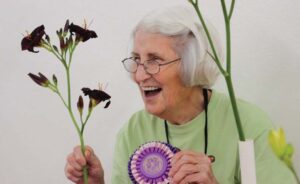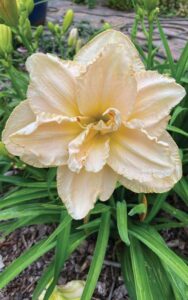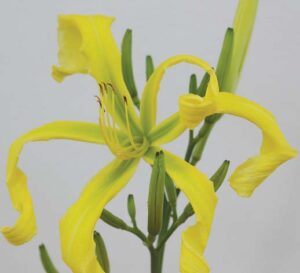Daylilies are a beautiful, dependable, and popular addition to the home landscape. Those who attended the Mid-Carolina Daylily Show and Sale at Asbury Church Fellowship Hall on June 7 experienced just how popular this herbaceous perennial plant really is.
According to Sylvia Beale, president of Mid-Carolina Daylily Society, “Crowds were lined up outside the hall, and when the doors opened at 2 p.m., the tables filled with daylilies lining the room were sold out by 2:18 p.m.”
Prior to opening the daylily exhibit to the public, exhibition judges had been busy evaluating various sections of the flower show. Exhibition judges are trained and certified by American Hemerocallis Society (AHS). Judges give numerical scores to each entry using the AHS scale of points. Flowers winning yellow ribbons must score at least 80 out of 100 points. Red ribbons score at least 85 points, blue ribbons score at least 90 points, and purple ribbons score 95 points. The top scores in each section are placed at the queen’s table where judges then select the Queen of the Show aka Best in Show.
Peggy Jeffcoat, Blythewood daylily grower, hybridizer, mentor to daylily gardeners, and cofounder of the Mid-Carolina Daylily Society in 1987, had numerous daylilies on the queen’s table—Best Seedling, Best Multi-flowered Form ‘Whimsical Whirlwind,’ Best Unusual Flower Form ‘Back to Black,’ and Best Spider Flower ‘Biloxi Memories.’ Her ‘Lil’ Black Buds’ won Best Miniature Flower and Best in Show.
The scientific name for daylily is Hemerocallis, meaning “beautiful for a day” in Greek. The name precisely describes the oneday bloom period of individual flowers. But since each plant produces many buds, the bloom time of an established clump may be a month or more. For those who enjoy their garden at night, Hemerocallis lilioasphodelus, is a lemony-yellow fragrant night-blooming daylily that attracts hummingbirds. With over 100,000 cultivars available, there’s a size and color for every garden.
The vibrant colors and flower structure of daylilies make them attractive to pollinators. Petal and sepal colors come in crèmes, gold, orange, pinks, reds, purples, yellows, and nearly black. There are also bicolors. Flowers come in a variety of shapes including circular, star, ruffled, spider-like, triangular, and trumpet. Daylilies range in height from one to five feet high. Flower width can range from two to eight inches.
Despite the common name, daylilies are not lilies or bulbs. They have a rhizomatous root system, which allows plants to spread but also absorb nutrients from the soil. Daylilies need a slightly acid (pH 6-6.5) well-drained soil amended with organic matter/compost. If drainage is a problem, plant them in containers or raised beds.
There are many excellent hybridizers and growers in the Mid-Carolina Daylily Society, an affiliate of the AHS, Region 15. Peggy Jeffcoat owns Singing Oakes Garden. Visitors are welcome to tour her daylily display and purchase plants by appointment. She also grows Hemerocallis ‘Peggy Jeffcoat.’ The Mid-Carolina Daylily Society meets the second Sunday of each month at the Garden Club Council building at 1605 Park Circle Drive near Maxcy Gregg Park.
For more information, visit www.midcarolinadaylilysociety.com.






Loading Comments